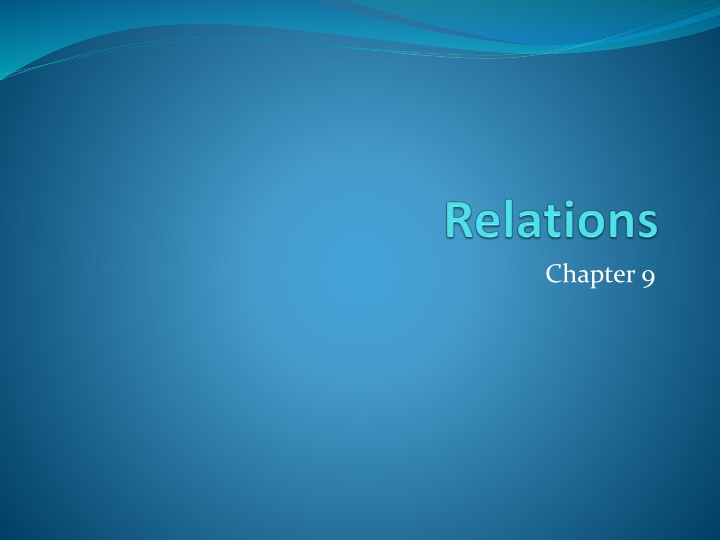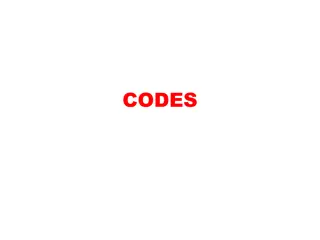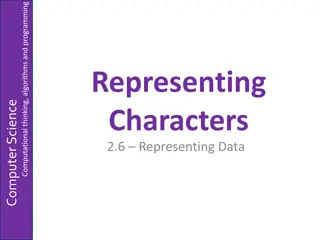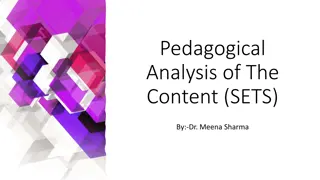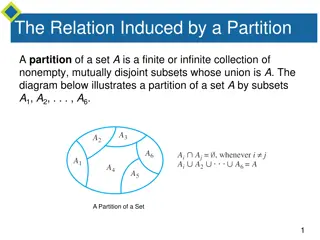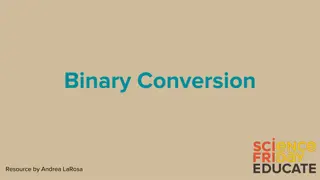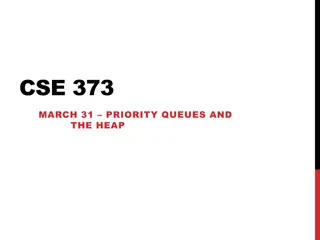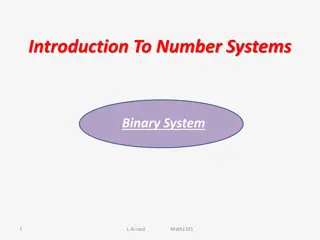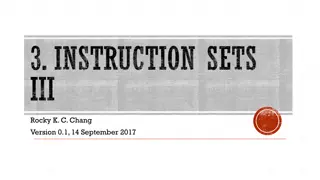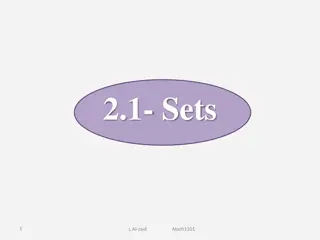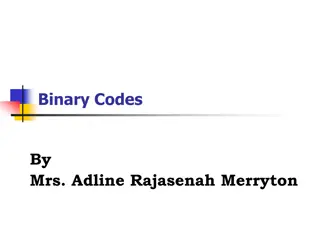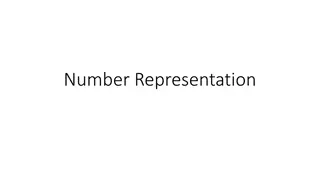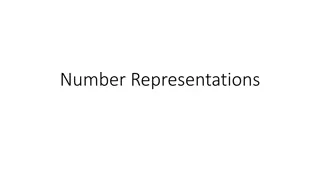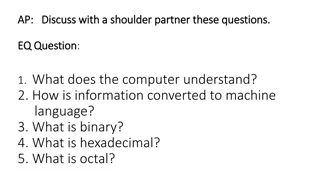Relations and Properties: Binary Relations on Sets
This chapter delves into binary relations, their definitions, and applications on sets. Explore examples and solutions regarding relations on sets and their properties like reflexivity, symmetry, and transitivity. Understand how to represent relations graphically and through tables.
Download Presentation

Please find below an Image/Link to download the presentation.
The content on the website is provided AS IS for your information and personal use only. It may not be sold, licensed, or shared on other websites without obtaining consent from the author.If you encounter any issues during the download, it is possible that the publisher has removed the file from their server.
You are allowed to download the files provided on this website for personal or commercial use, subject to the condition that they are used lawfully. All files are the property of their respective owners.
The content on the website is provided AS IS for your information and personal use only. It may not be sold, licensed, or shared on other websites without obtaining consent from the author.
E N D
Presentation Transcript
Chapter Summary Relations and Their Properties n-ary Relations and Their Applications (not currently included in overheads) Representing Relations Closures of Relations (not currently included in overheads) Equivalence Relations Partial Orderings
Section Summary Relations and Functions Properties of Relations Reflexive Relations Symmetric and Antisymmetric Relations Transitive Relations Combining Relations
Binary Relations Definition: A binary relation R from a set A to a set B is a subset R A B. Example: Let A = {0,1,2} and B = {a,b} {(0, a), (0, b), (1,a) , (2, b)} is a relation from A to B. We can represent relations from a set A to a set B graphically or using a table: Relations are more general than functions. A function is a relation where exactly one element of B is related to each element of A.
Binary Relation on a Set Definition: A binary relation Ron a set A is a subset of A A or a relation from A to A. Example: Suppose that A = {a,b,c}. Then R = {(a,a),(a,b), (a,c)} is a relation on A. Let A = {1, 2, 3, 4}. The ordered pairs in the relation R = {(a,b) | adivides b} are (1,1), (1, 2), (1,3), (1, 4), (2, 2), (2, 4), (3, 3), and (4, 4).
Binary Relation on a Set (cont.) Question: How many relations are there on a set A? Solution: Because a relation on A is the same thing as a subset of A A, we count the subsets of A A.Since A A has n2 elements when A has n elements, and a set with m elements has 2m subsets, there are subsets of A A. Therefore, there are relations on a set A. 2A 2 | | 2A 2 | |
Binary Relations on a Set (cont.) (SELF STUDY) Example: Consider these relations on the set of integers: R1 = {(a,b) | a b}, R4 = {(a,b) | a= b}, R2 = {(a,b) | a> b}, R5 = {(a,b) | a= b + 1}, R3 = {(a,b) | a= b or a = b}, R6 = {(a,b) | a + b 3}. Note that these relations are on an infinite set and each of these relations is an infinite set. Which of these relations contain each of the pairs (1,1), (1, 2), (2, 1), (1, 1), and (2, 2)? Solution: Checking the conditions that define each relation, we see that the pair (1,1) is in R1, R3, R4 , and R6: (1,2) is in R1and R6: (2,1) is in R2, R5,and R6: (1, 1) is in R2, R3,and R6 : (2,2) is in R1, R3,and R4.
Reflexive Relations Definition: Ris reflexive iff (a,a) Rfor every element a A. Written symbolically, R is reflexive if and only if x[x U (x,x) R] Example: The following relations on the integers are reflexive: R1 = {(a,b) | a b}, R3 = {(a,b) | a= b or a = b}, R4 = {(a,b) | a= b}. The following relations are not reflexive: R2 = {(a,b) | a> b} (note that 3 3), R5 = {(a,b) | a= b + 1} (note that 3 3 + 1), R6 = {(a,b) | a + b 3} (note that 4 + 4 3). If A= then the empty relation is reflexive vacuously. That is the empty relation on an empty set is reflexive!
Symmetric Relations Definition:R is symmetric iff (b,a) R whenever (a,b) R for all a,b A. Written symbolically, R is symmetric if and only if x y [(x,y) R (y,x) R] Example: The following relations on the integers are symmetric: R3 = {(a,b) | a= b or a = b}, R4 = {(a,b) | a= b}, R6 = {(a,b) | a + b 3}. The following are not symmetric: R1 = {(a,b) | a b} (note that 3 4, but 4 3), R2 = {(a,b) | a> b} (note that 4 > 3, but 3 4), R5 = {(a,b) | a= b + 1} (note that 4 = 3 + 1, but 3 4 + 1).
Transitive Relations Definition: A relation R on a set A is called transitive if whenever (a,b) Rand (b,c) R, then (a,c) R, for all a,b,c A. Written symbolically, R is transitive if and only if x y z[(x,y) R (y,z) R (x,z) R ] Example: The following relations on the integers are transitive: R1 = {(a,b) | a b}, R2 = {(a,b) | a> b}, R3 = {(a,b) | a= b or a = b}, R4 = {(a,b) | a= b}. The following are not transitive: R5 = {(a,b) | a= b + 1} (note that both (3,2) and (4,3) belong to R5, but not (3,3)), R6 = {(a,b) | a + b 3} (note that both (2,1) and (1,2) belong to R6, but not (2,2)). For every integer, a b andb c, then b c.
